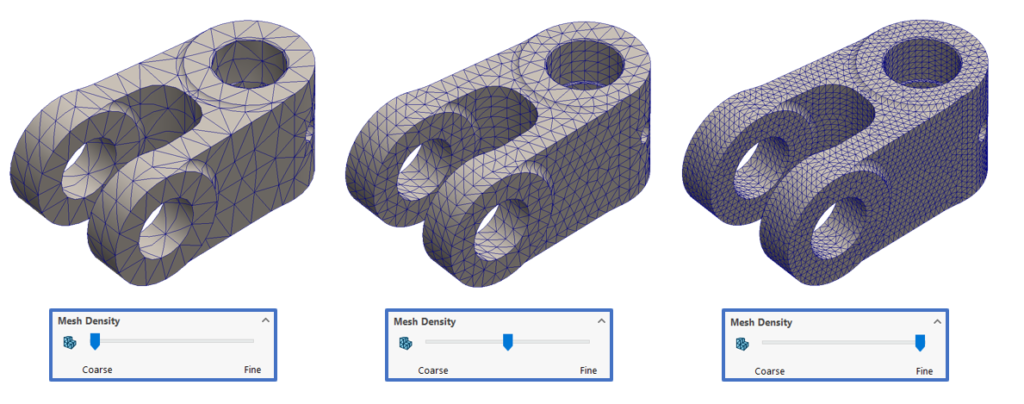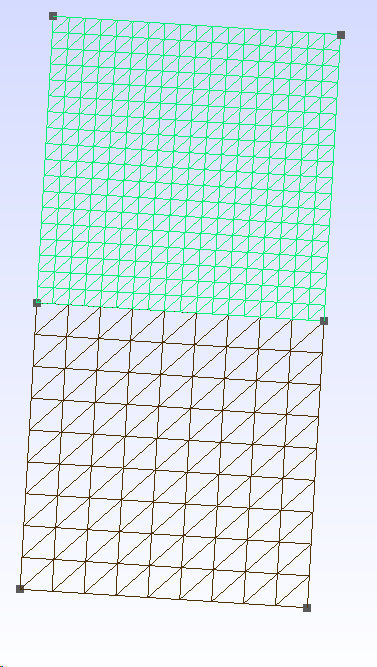
As a more complicated mechanism, 3-D SAR imaging algorithms of complex targets in real-time remained for further study.Īdditional challenge in the real world is that targets cannot be regarded as electrically small ones at high-frequency bands thus, reducing time consumption due to the computational complexity is of great interest. Unfortunately, the amount of calculation is still too high to satisfy the requirements of real-time imaging.
#Change mesh size gui gmsh series
proposed the nonlinear frequency scaling algorithm based on series reversion method to derive the point target spectrum.

In 2004, the polar format algorithm was proposed (Rigling & Moses, 2004), which, taking a bistatic far-field assumption as a foundation, generates images for small scenes by using two-dimensional (2-D) interpolation, with the computational complexity of O( N 2log 2 N) and a lower accuracy level than previous algorithms. Furthermore, Ding and Munson ( 2002) improved the BP and proposed a fast BP (FBP) algorithm, which reduces the computational complexity to O( N 2log 2 N).

However, the computational complexity of BP is O( N 3). In early bistatic SAR imaging algorithm, the backprojection (BP) algorithm was proposed by Soumekh in 1998, using the principle of time-domain matched filtering image formation algorithm to achieve high accuracy. In addition, the development of imaging algorithms for bistatic SAR requires to overcome some limitations due to motion error compensation and the bottleneck of computation complexity. German Aerospace Center researchers also introduced an innovative concept of multidimensional waveform encoding for spaceborne SAR and optimized strategies for high-resolution wide-swath SAR imaging during this period (Gebert et al., 2009 Krieger et al., 2008). It is expected that the implementation of the MIMO-SAR concept in inverse SAR will improve the functionality of imaging radars. From 2006, a research group in Germany started to develop ARTINO 3-D imaging SAR by using a MIMO array (Ender & Klare, 2009). They can be seen as the prototype of MIMO radars (Chen et al., 2001 Dorey & Garnier, 1989). RIAS (Radar à Impulsion et Antenne Synthétiques) was invented by ONERA in 1989, while a sparse-array synthetic impulse and aperture radar was proposed by National Laboratory of Radar Signal Processing of Xidian University. For radar applications, MIMO is a new technology. In recent years, significant effort of both the scientific and industrial research community is invested in electromagnetic (EM) wave scattering for remote sensing applications, especially for multiple-input multiple-output (MIMO)-SAR technology (Younis et al., 2013). Furthermore, three-dimensional (3-D) radar imaging and objects reconstruction have strong potentials in various applications, such as surveillance, monitoring, and positioning of the aircrafts, fishing boats, and stealth targets for homeland defense and the safeguard of national economy. Compared with monostatic systems, bistatic SAR is a type of SAR imaging radar system that uses separated transmitters and receivers on different platforms to obtain more flexible imaging geometry configuration than the conventional SAR (Lazarov & Kostadinov, 2014). One of the milestones in remote sensing is the development of multifrequency, multipolarization, and high-resolution synthetic aperture radar (SAR). Finally, numerical experiments indicate that 3-D visualization of sphere, and examples of fighter aircraft and aircraft carrier are generated within 200 s, further proving correctness and effectiveness of the developed 3-D MIMO SAR imaging algorithm. The SAR simulation system includes the following: (i) refined geometric-electromagnetic modeling by Gmsh, (ii) a dynamic sea surface model, (iii) single-input multiple-output (SIMO) radar imaging formation by employing a fast backprojection algorithm, (iv) design of MIMO antenna arrays to achieve a good trade-off between the main beam width and the side lobe level, (v) 3-D SAR imaging algorithm on the basis of optimized physical optics for electromagnetic scattering computation, and (vi) hardware acceleration technique using graphics processing unit. Specifically, a reasonable sea surface model to quantify the influence of physical parameters in clutter was yielded as well.

In this paper, an advanced multiple-input multiple-output (MIMO) SAR based on high-resolution imaging algorithm was developed.

One of the key issues is to realize efficient methods for imaging, reconstruction, and target detection of three-dimensional (3-D) electrically large-scale objects. In recent years, significant effort of both the scientific and industrial community is invested in research and development of multifrequency, multipolarization, and high-resolution synthetic aperture radar (SAR) systems.


 0 kommentar(er)
0 kommentar(er)
